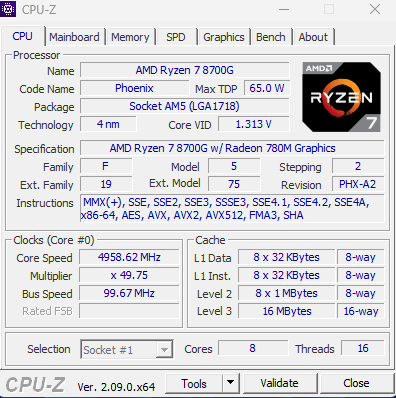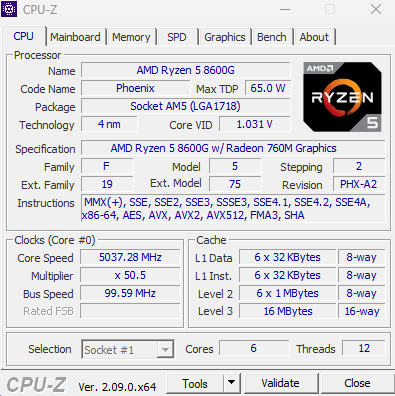Zen 4 APUs with RDNA3 Graphics
One of the most desired desktop chips designed for low-cost systems has been AMD’s APUs, or Accelerated Processing Units. The last time we saw AMD launch a series of APUs for desktops was back in 2021, with the release of their Cezanne-based Ryzen 5000G series, which combined Zen 3 cores with Radeon Vega-based integrated graphics. During CES 2024, AMD announced the successor to Cezanne, with new Phoenix-based APUs, aptly named the Ryzen 8000G series.
The latest Ryzen 8000G series is based on their mobile-focused Phoenix silicon, and has been refitted for AMD’s AM5 desktop platform. Designed to give users and gamers on a budget a pathway to build a capable-yet-cheaper system without the requirement of a costly discrete graphics card hanging over their head, the Ryzen 8000G series consists of three retail SKUs, ranging from an entry-level Phoenix 2-based Zen 4 and Zen 4c hybrid chip, all the way to a full Zen 4 8C/16T model with AMD’s latest mobile RDNA3 integrated graphics.
The Ryzen 7 8700G with 8C/16T, 16 MB of L3 cache, and AMD’s Radeon 780M graphics are sitting at the top of the pile. The other chip we’re taking a look at today is the middle-of-the-road AMD Ryzen 5 8600G, which has a 6C/12T configuration with fully-fledged mobile Zen 4 cores, with a third option limited to just OEMs currently, with four cores, including one full Zen 4 core and three smaller and more efficient Zen 4c cores.
The other notable inclusion of AMD’s Ryzen 8000G series is it brings their Ryzen AI NPU into the desktop market for the first time. It is purposely built for efficiently executing local AI inferencing workloads, using a fraction of the power and resources that the CPU or GPU cores would otherwise take.
Much of the onus on the capability of AMD’s Ryzen 8000G series will be how much of an impact the switch to Zen 4 and RDNA3 integrated graphics commands over the Ryzen 5000G series with Zen 3 and Vega, which is already three years old at this point. The other element is how the mobile-based Phoenix Zen 4 cores compare to the full-fat Raphael Zen 4 cores. In our review and analysis of the AMD Ryzen 7 8700G and Ryzen 5 8600G APUs, we aim to find out.
AMD Ryzen 8000G Series: Zen 4 APUs w/ RDNA3 Graphics
As AMD strides into 2024, the spotlight is on artificial intelligence technology. The Ryzen 7 8700G and Ryzen 5 8600G models are both equipped with the embedded Ryzen AI NPU, enhancing on-chip AI inferencing capabilities. Consistent with AMD’s approach in recent generations, the Ryzen 8000G series APUs are not built from entirely new silicon. Instead, they use AMD’s existing monolithic “Phoenix” family of dies, which are already in use in the mobile market as the Ryzen Mobile 7000/8000 series. Both Phoenix (1) and its low-cost compatriot, Phoenix 2, are being drawn in by AMD for desktop use with the Ryzen 8000G series.
Targeting budget-conscious gamers and entry-level users, the Ryzen 8000G series amalgamates key features from the Ryzen 7000 desktop series and the Ryzen 8000 mobile series. Notably, each of the four models in the Ryzen 8000G series maintains a TDP of 65 watts. This is slightly higher than their mobile counterparts but offers more power headroom on desktops, especially useful for hitting (and sustaining) higher clockspeeds on things like the Radeon RDNA3-based graphics block.
Similar to its predecessors, including the previous Zen 3-based Ryzen 7 5700G, Ryzen 5 5600G, and Ryzen 3 5300G, the latest Zen 4 Ryzen 8000G series of APUs from AMD continues to provide the dual advantages of a unified, mobile-oriented die architecture while maintaining a strong presence in the entry-level desktop market.
Shifting focus to their intended audience, AMD offers the assurance of ‘ready to game out of the box at 1080p’ performance levels. 1080p remains the most common resolution among gamers by far, as indicated by the latest Steam Hardware Survey. However, it’s important to note that these chips are not tailored for high-end AAA gaming at 1080p. Users looking to play more graphically demanding games should be prepared to adjust the quality settings accordingly or opt to purchase a discrete graphics card – though if you’re planning on using a discrete card from the start, you may want to look at AMD’s traditional CPUs.
| AMD Ryzen 8000G vs. Ryzen 5000G Series (Desktop) Zen 3 vs Zen 4 APUs (65 W) | |||||||||
| AnandTech | Cores | Base Freq | Turbo Freq | GPU | GPU Freq | Ryzen AI (NPU) | L3 Cache (MB) | TDP | MSRP |
| Ryzen 7 | |||||||||
| Ryzen 7 8700G | 8x Z4 | 4200 | 5100 | R780M 12 CUs | 2900 | Y | 16 | 65W | $329 |
| Ryzen 7 5700G | 8x Z3 | 3800 | 4600 | Vega 8 8 CUs | 2000 | N | 16 | 65W | $359 |
| Ryzen 5 | |||||||||
| Ryzen 5 8600G | 6x Z4 | 4300 | 5000 | R760M 8 CUs | 2800 | Y | 16 | 65W | $229 |
| Ryzen 5 8500G | 2x Z4 4x Z4c | 3500 | Z4: 5000 Z4c: 3700 | R740M 4 CUs | 2800 | N | 16 | 65W | $179 |
| Ryzen 5 5600G | 6x Z3 | 3900 | 4400 | Vega 7 7 CUs | 1900 | N | 16 | 65W | $259 |
| Ryzen 3 | |||||||||
| Ryzen 3 8300G* | 1x Z4 3x Z4c | 3400 | Z4: 4900 Z4c: 3600 | R740M 4 CUs | 2600 | N | 8 | 65W | OEM Only |
| Ryzen 3 5300G | 4x Z3 | 4000 | 4200 | Vega 6 6 CUs | 1700 | N | 8 | 65W | OEM Only |
| *Currently OEM only (End of Q1 2024, other SKUs available 31/01/24 | |||||||||
The Ryzen 7 8700G leads the lineup, rooted in AMD’s Phoenix mobile silicon, offering eight Zen 4 cores (8C/16T). This top-tier model offers a turbo frequency of 5.1 GHz and a base frequency of 4.2 GHz, which, compared to the previous Zen 3-based Ryzen 7 5700G, offers a 500 MHz bump in turbo clock speeds alone, as well as architectural advancements brought about by Zen 4.
As a true APU on AMD’s AM5 desktop platform, it integrates Radeon 780M graphics based on the RDNA3 architecture, featuring advanced capabilities like Hyper-RX and Fluid Motion Frames (frame interpolation). The Radeon 780M is equipped with 12 CUs and 768 shader units (1536 ALUs), operating at a clock speed of 2.9 GHz.
Meanwhile, as AMD rightly claims, the Ryzen 8000G series, with the Ryzen 7 8700G and Ryzen 5 8600G, are the first desktop processors on the market to come with a dedicated AI engine, namely Ryzen AI. On paper, the Ryzen 7 8700G is a powerhouse for on-chip AI inferencing, with AMD offering software developers an NPU, CPU, and GPU for AI inferencing, depending on their use case and performance needs.
The Ryzen 5 8600G is positioned just below the 8700G and features six Zen 4 cores (6C/12T), reaching a maximum turbo frequency of 5.0 GHz and a base frequency of 4.3 GHz. It also houses the Radeon 760M RDNA3 integrated graphics with 8 CUs and 512 shader units clocking at 2.8 GHz. Like the Ryzen 7 8700G, the 8600G model incorporates the Ryzen AI NPU engine, a technology AMD acquired through their 2022 Xilinx acquisition, highlighting both model’s on-chip AI inferencing capabilities and bringing Ryzen AI directly from their mobile chipset straight to the desktop.
AMD Ryzen 7 8700G screenshot in CPU-Z
Although AMD hasn’t sampled us with the Ryzen 5 8500G or the Ryzen 3 8300G, they are built differently than the other two Ryzen 8000G APUs. The Ryzen 5 8500G uses AMD’s budget Phoenix 2 die, which blends two Zen 4 cores with four energy-efficient Zen 4c cores. The chip offers a base speed of 3.5GHz, while the big Zen 4 cores can turbo up to 5.0GHz, and the smaller Zen 4c cores have a peak clockspeed of 3.7GHz. This transition to the Phoenix 2 architecture drops the Ryzen AI NPU and scales down the integrated graphics to a 4 CU Radeon 740M with a 2.8GHz peak graphics frequency. Mirroring the mobile Ryzen 5 8540U in several aspects, the 8500G stands out with a higher 65W TDP, which is more adequately suited for AMD’s AM5 desktop platform.
Complementing the lineup, the entry-level Ryzen 3 8300G, which is only being sold to system integrators and OEMs, and features a mix of one full Zen 4 core and three Zen 4c cores, with up to 4.9 GHz turbo speeds on the single Zen 4 core. This model also sees a reduction in L3 cache to 8MB, alongside 4MB of L2 cache, balancing its capabilities for basic computing tasks.
For users looking to leverage the AMD Radeon RDNA3-based integrated graphics, a motherboard with at least one form of video output is required. The Ryzen 8000G series APUs are supported by all of AMD’s AM5 chipsets, including X670E, X670, B650E, B650, and A620. Users looking to use a discrete graphics card can select any AM5 board currently on the market. However, as mentioned, the iGPU requires a video output such as a DisplayPort or HDMI output.
AMD Ryzen 5 8600G screenshot in CPU-Z
Regarding the target audience for AMD’s Ryzen 8000G series processors, they are suited to users looking to build a competent system capable of gaming at lower resolutions and offering a good level of compute performance. At the lower end of the PC hardware spectrum, price is a key characteristic, and given that Ryzen 8000G only supports DDR5 memory through the AM5 chipset, we’re not seeing the same value we saw with AM4.
This brings the overall value into question, with the top SKU, the Ryzen 7 8700G, coming with an MSRP of $329, which puts it $30 cheaper than the previous Ryzen 7 5700G ($359) at launch. The Ryzen 7 5700G is currently $170 at Amazon (at the time of writing), while the Ryzen 5 5600G costs just $124 at Amazon. Tie that into the MSRP of the Ryen 5 8600G at $229. It’s also worth pointing out how much cheaper adopting the AM4 platform with DDR4 memory can be at the entry-level market, and we’re looking at some stern competition. The added benefit is that the Ryzen 8000G comes with Ryzen AI and on-chip AI capabilities, along with the jump in generational performance going from Zen 3 to Zen 4, DDR5 vs. DDR4, and of course, the latest RDNA3 mobile graphics too.
Source link


